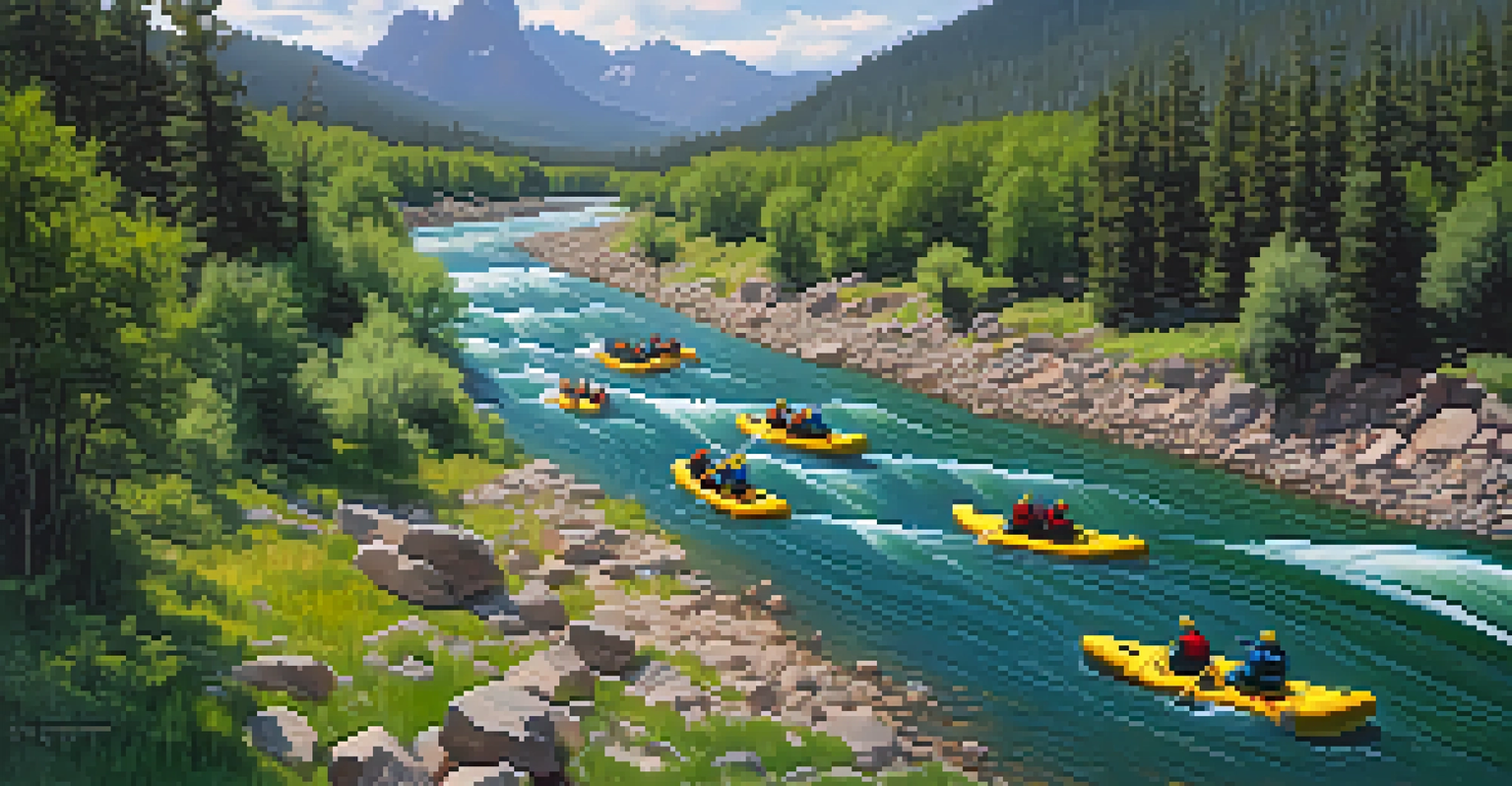Balancing Adventure and Conservation in Colorado Tourism

Understanding Colorado's Unique Natural Landscape
Colorado is renowned for its breathtaking landscapes, from the majestic Rocky Mountains to serene alpine lakes. This diverse geography attracts millions of tourists each year, eager to hike, ski, and explore its beauty. However, this influx of visitors can put a strain on the environment, raising questions about how to protect these natural treasures while still welcoming adventure seekers.
The greatest threat to our planet is the belief that someone else will save it.
The state is home to several national parks, forests, and wilderness areas that are vital for biodiversity. These regions serve as habitats for wildlife, as well as recreational spaces for people. Balancing the needs of tourism with the preservation of these ecosystems is crucial for maintaining Colorado's charm and ecological integrity.
As we delve into the relationship between adventure and conservation, understanding the impact of tourism on the environment becomes essential. This knowledge can help guide policies and practices that ensure Colorado remains a playground for future generations while safeguarding its natural resources.
The Role of Responsible Tourism in Conservation
Responsible tourism practices are key to ensuring that outdoor adventures do not harm Colorado's environment. This approach encourages visitors to respect natural spaces, support local communities, and minimize their ecological footprint. By promoting sustainable activities like hiking, biking, and wildlife viewing, tourists can enjoy the beauty of Colorado while actively contributing to its conservation.

Education plays a critical role in responsible tourism. Tour operators and guides can inform visitors about the importance of staying on marked trails, respecting wildlife, and practicing Leave No Trace principles. When tourists are equipped with knowledge, they are more likely to make choices that benefit the environment and support conservation efforts.
Balance Tourism and Conservation
Striking a balance between tourism and conservation is essential to protect Colorado's natural landscapes while still welcoming adventure seekers.
Moreover, responsible tourism can have economic benefits for local communities. By prioritizing eco-friendly practices, businesses can attract a niche market of environmentally conscious travelers, ultimately leading to a more sustainable tourism model that benefits both nature and the economy.
Adventure Sports: A Double-Edged Sword
Adventure sports, such as rock climbing, mountain biking, and white-water rafting, are a significant draw for tourists in Colorado. While these activities offer exhilarating experiences, they can also lead to environmental degradation if not managed properly. For instance, excessive foot traffic can erode trails, and waste from recreational activities can pollute water sources.
Nature does not hurry, yet everything is accomplished.
It is essential for adventure sports operators to adopt sustainable practices that mitigate their environmental impact. This includes implementing trail maintenance programs, offering eco-friendly gear, and educating participants on conservation practices. By taking responsibility, adventure sports can become a force for good in preserving Colorado's natural beauty.
Additionally, collaboration between outdoor recreation businesses and conservation organizations can lead to innovative solutions. By working together, they can develop guidelines and promote stewardship initiatives that ensure adventure sports enhance rather than harm the environment.
Community Involvement in Conservation Efforts
Local communities play a vital role in balancing tourism and conservation in Colorado. Engaging residents in conservation initiatives not only fosters a sense of ownership but also creates a culture of stewardship. Communities can organize clean-up events, educational workshops, and guided tours that highlight the importance of preserving local ecosystems.
Moreover, involving community members in decision-making processes about tourism development ensures that their voices are heard. This can lead to more sustainable practices that reflect the needs and values of the community while prioritizing environmental protection. When locals feel empowered, they are more likely to contribute positively to the tourism landscape.
Community Involvement is Key
Engaging local communities in conservation efforts fosters stewardship and ensures that tourism practices align with their values.
By fostering partnerships between local businesses, government, and conservation groups, Colorado can create a cohesive strategy for sustainable tourism. This approach strengthens community ties and reinforces the idea that everyone has a role in protecting the beautiful environment that draws tourists to the state.
The Impact of Climate Change on Tourism
Climate change poses significant challenges for Colorado's tourism industry, affecting everything from snowfall patterns to wildflower blooms. Warmer temperatures can shorten ski seasons and alter the timing of outdoor activities, which may lead to decreased visitor numbers. As a result, the tourism sector must adapt to these changes while remaining committed to conservation efforts.
Understanding climate change's impact enables tourism stakeholders to develop strategies that enhance resilience. This includes diversifying offerings, such as promoting summer activities like hiking and biking, to offset winter declines. By being proactive and adapting to these environmental changes, Colorado can continue to attract tourists year-round.
Additionally, raising awareness about climate change among tourists can foster a sense of responsibility. Encouraging visitors to participate in eco-friendly practices, such as carbon offset programs or supporting local conservation projects, reinforces the importance of collective action in combating climate change.
Leveraging Technology for Sustainable Tourism
Technology can play a pivotal role in promoting sustainable tourism practices in Colorado. From mobile apps that provide real-time information on trail conditions to platforms that facilitate eco-friendly travel options, technology can enhance the visitor experience while supporting conservation efforts. By utilizing these tools, tourists can make informed decisions that positively impact the environment.
Moreover, virtual reality experiences can offer immersive previews of outdoor activities, encouraging responsible planning and reducing the likelihood of overcrowding in sensitive areas. This helps to distribute tourist traffic more evenly across Colorado's natural spaces, minimizing the strain on popular destinations.
Adapt to Climate Change Challenges
Addressing the impacts of climate change on tourism requires proactive strategies to diversify offerings and promote eco-friendly practices.
Social media also serves as a powerful platform for raising awareness about conservation initiatives. By sharing success stories and promoting eco-friendly practices, tourism stakeholders can inspire visitors to engage in sustainable behaviors that protect Colorado's environment for future generations.
Creating a Vision for Sustainable Tourism in Colorado
A unified vision for sustainable tourism in Colorado requires collaboration among all stakeholders, including government, businesses, and communities. By establishing clear goals and strategies, Colorado can foster a tourism model that prioritizes environmental conservation while offering exciting adventures. This vision should encompass responsible practices, community engagement, and innovative solutions to challenges like climate change.
Implementing policies that promote sustainable tourism, such as incentivizing eco-friendly businesses or investing in conservation projects, can help create a thriving tourism industry that respects nature. Additionally, ongoing dialogue and feedback from the community ensure that the vision remains relevant and responsive to changing needs.

Ultimately, balancing adventure and conservation in Colorado is not just a goal but a necessity. By working together, stakeholders can create a sustainable tourism model that showcases the beauty of Colorado while protecting its natural resources for generations to come.